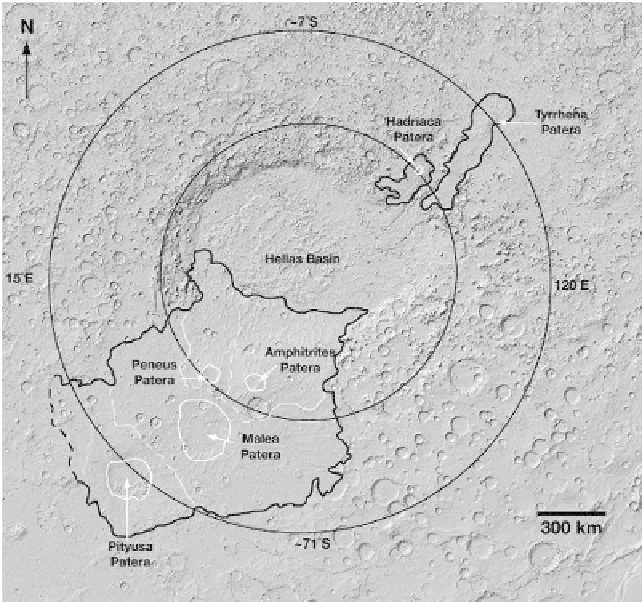Geology Reference
In-Depth Information
orbit around Mars, as was done for the discovery of
mascons for the Moon. These data suggest that the crust
is 70
-
80 km thick in the older terrain of the southern
highlands and thins northward to 35
-
40 km in the lowland
plains. It is also thin beneath large impact structures, such
as Hellas
(Fig. 7.2)
.
In contrast to the crust, the lithosphere (the physically
rigid outer shell of planets) appears to be relatively thin in
the older terrains, such as the cratered highlands, where it
is modeled to be <20 km thick, and to be as thick as
100 km in the youngest terrains. This relationship is
thought to re
ect the thermal history of Mars, which in
early times involved high heat
flow from the interior,
leading to a thin rigid zone at the surface. Progressively
lower heat
flow as the planet cooled enabled a thicker rigid
zone to develop.
As with Venus, there is debate regarding the style of
tectonics on Mars. Following global imaging of Mars by
Mariner 9, terrains were searched for evidence of plate
tectonics, but none was found. Nonetheless, geophysists
modeled the thermal evolution of Mars and debated the
possibility, but there was little agreement on the results.
One of the most exciting discoveries of the MGS mis-
sion was the presence and distribution of a remnant mag-
netic
field in the ancient terrain of Mars. Because the
terrains associated with the large impact structures
7.3 Interior
As with the other terrestrial planets, the interior of Mars is
partitioned into a core, mantle, and crust/lithosphere, re
ect-
ing differentiation following its formation. Although the
thicknesses of each zone are not well known, our knowl-
edge of the size and density of Mars enables some estimates
to be made. The overall density of Mars is lower than that of
Earth, even taking into account the difference in diameters
and the corresponding adjustments for interior properties
(i.e., gravitational compensation). If the core is mostly
iron with some oxygen and sulfur, geophysical models
suggest a core diameter of ~4,400 km. On the other hand,
if the core is composed of nickel
-
iron, it would be only
~2,600 km in diameter. Thus, depending on the core size,
the mantle would be 1,500
-
2,100 km thick with a density of
3.52 g/cm
3
. By analogy with Earth, the martian mantle
is likely to include various sub-zones, but this idea cannot
be tested in the absence of seismic data.
The surface of Mars
'
crust (the compositionally distinct
zone of a planet) is mostly ma
c, according to remote
sensing data, laboratory analyses of martian meteorites,
and data obtained from landed spacecraft. The crustal
thickness can be derived from gravity data determined
from tracking perturbations in the paths of spacecraft in
3.41
-
Figure 7.2. A shaded relief map of the Hellas
impact basin, showing its inferred structural rings
(concentric circles) and the Circum-Hellas Volcanic
Province; white outlines show the positions of
calderas and the associated volcanic deposits.




